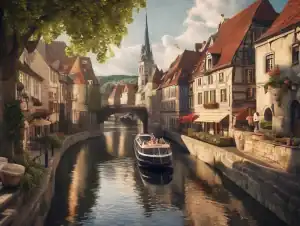Valentine’s Day is celebrated worldwide as a day of love and romance, but its roots run much deeper than modern traditions suggest. With a rich history stretching back to the medieval era, this holiday is filled with fascinating stories and customs that shaped how we express affection today. In this article, discover 10 fascinating facts about Valentine’s Day with a medieval twist, revealing the surprising origins and timeless charm behind one of the most beloved celebrations.
While it’s often associated with modern customs like exchanging flowers, cards, and chocolates, the origins of this romantic holiday are deeply rooted in history, particularly in medieval traditions.
Here are ten fascinating facts about Valentine’s Day with a focus on its medieval origins and influences:
1. The Feast of Saint Valentine
Valentine’s Day traces its origins back to the Feast of Saint Valentine, a Christian martyr who lived during the Roman Empire in the 3rd century AD. While there were multiple martyrs named Valentine, it’s widely believed that the holiday is named after a Roman priest named Valentine who defied Emperor Claudius II’s ban on marriage for young men.

2. Chaucer’s Influence
Geoffrey Chaucer, the renowned English poet of the Middle Ages, played a significant role in popularizing Valentine’s Day as a celebration of romantic love. In his poem “Parlement of Foules” (Parliament of Fowls), written in the late 14th century, Chaucer linked the tradition of courtly love with the feast day of Saint Valentine, helping to establish the holiday’s romantic associations.

3. Medieval Love Letters
During the Middle Ages, the exchange of love letters became a popular custom among nobility and courtly circles. These letters often featured elaborate language and expressions of undying affection, reflecting the ideals of courtly love that were prevalent during the medieval era.
4. Valentine’s Day Cards
While the tradition of exchanging handmade valentine cards didn’t become widespread until much later, the practice of sending written expressions of love on Valentine’s Day has medieval roots. Wealthy individuals in medieval Europe would commission poets and scribes to create customized love letters and poems for their beloveds.
5. Valentine’s Day Festivities
In medieval Europe, Valentine’s Day was celebrated with various festivities and social gatherings. These events often included feasting, dancing, and entertainment, providing an opportunity for young men and women to socialize and potentially find love.

6. Valentine’s Day Symbols
Many of the symbols associated with Valentine’s Day, such as hearts, doves, and Cupid, have origins in medieval art and literature. For example, Cupid, the Roman god of love, was often depicted with a bow and arrow, symbolizing his ability to pierce hearts and inspire love.
7. Valentine’s Day Superstitions
In medieval folklore, Valentine’s Day was associated with various superstitions and divination rituals aimed at predicting one’s future romantic prospects. For example, young women would perform rituals involving mirrors or apple peels to catch a glimpse of their future spouse.
8. Valentine’s Day Traditions Around the World
While Valentine’s Day has its roots in European traditions, similar celebrations of love and romance can be found in various cultures around the world. In medieval Japan, for instance, the festival of Tanabata celebrated the meeting of two star-crossed lovers, Orihime and Hikoboshi, on the seventh day of the seventh lunar month.

9. Valentine’s Day in Literature
Throughout the medieval period and beyond, love and romance were popular themes in literature. From epic poems like “Tristan and Isolde” to courtly romances like “Lancelot and Guinevere,” tales of passion and devotion captured the imagination of medieval audiences and continue to inspire storytellers to this day.

10. Modern Celebrations
While Valentine’s Day has evolved over the centuries, its essence as a day to celebrate love and affection remains timeless. Today, people around the world mark the occasion with gestures of love and appreciation for their partners, friends, and family members, keeping alive the spirit of romance that has enchanted hearts since medieval times.

In conclusion, Valentine’s Day is not just a modern invention but a holiday with deep roots in medieval history and culture.
By exploring its fascinating origins and influences, we gain a greater appreciation for the enduring tradition of celebrating love and romance on this special day.
What is the medieval origin of Valentine’s Day?
Valentine’s Day traces back to medieval times when it was linked to the feast of Saint Valentine and romantic courtly traditions.
How did medieval people celebrate Valentine’s Day?
Medieval celebrations included exchanging handwritten love notes, poems, and tokens, laying the foundation for today’s Valentine’s traditions.
Who was Saint Valentine in medieval history?
Saint Valentine was a priest known for secretly marrying couples during a time when marriage was banned, making him a symbol of love and devotion.
What are some medieval symbols associated with Valentine’s Day?
Symbols like hearts, doves, and roses originated or gained popularity during the medieval period, representing love and affection.
When did Valentine’s Day become associated with romantic love?
The association began in the Middle Ages, inspired by the writings of poets like Geoffrey Chaucer who linked the day to courtly love.
Why is the medieval period important to understanding Valentine’s Day?
The medieval era shaped many of the customs, symbols, and literary traditions that define Valentine’s Day as a celebration of romantic love.
Are any Valentine’s Day traditions still practiced from medieval times?
Yes, exchanging love letters and giving flowers continue to be popular practices rooted in medieval customs.





